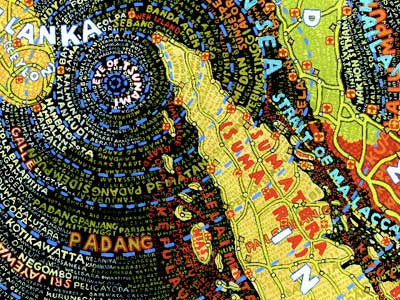Desktop Digital Revolution and the Birth of Onedotzero
Year 1996. New desktop digital filmmaking tools are becoming available. It’s the beginning of the desktop digital revolution – a dawn of a new era in new media and motion design. A writer and former film critic Matt Hanson creates a film festival designed to showcase the vibrant new media collectives and digital arts scene burgeoning in London. Onedotzero is born. The festival becomes a platform to explore innovative moving image, live audiovisual performances, interaction design, computer gaming visuals, music videos, commercials in film and arts contexts.
Year 2009. After touring Buenos Aires, Argentina, New York, France and Russia Onedotzero festival returns to the BFI in London to once again amaze us with groundbreaking and inspiring works. “Decode: Digital Design Sensations”, which Onedotzero co-curates with the V&A Museum, showcases the latest developments in digital and interactive design from small screen based graphics to large-scale installations. The exhibition includes 35 works by established international artists and designers including Daniel Brown, Golan Levin and Daniel Rozin as well as emerging designers such as Troika and Mehmet Akten.
The exhibition that we saw in January 2010 certainly helped me to understand the today’s “computer-generated world of animated digital design”.
Quest for the Pioneers

The history of animation goes back to palaeolithic cave paintings, where animals are depicted with multiple sets of legs in superimposed positions, clearly attempting to convey the perception of motion. Other examples include a 5,200-year old earthen bowl found in Iran in Shahr-i Sokhta showing phases of a goat leaping up to nip at a tree and a 4,000 years old Egyptian mural with the images of wrestlers in action.
Motion design, however, has truly been developed only in the 20th century. It is being defined as a subset of graphic design that uses film, video or animation techniques.
Early examples include the typography and graphics used as the titles for a film, or opening sequences for television programs.
Among the precursors of the discipline you will find:
- Saul Bass – an American graphic designer and Academy Award-winning filmmaker known best for his design on animated motion picture title sequences. Amongst his most famous title sequences are the animated paper cut-out of a heroin addict's arm for Preminger's The Man with the Golden Arm, the text racing up and down what eventually becomes a high-angle shot of the United Nations building in Alfred Hitchcock's North by Northwest, and the disjointed text that raced together and was pulled apart for Psycho (1960).
- Maurice Binder - a famous title designer best known for his work on 14 James Bond films including the first, Dr. No (1962). Binder created the signature gun barrel sequence as well as the opening title credits, showing an artistic display of scantily clad and often discreetly naked females doing a variety of activities such as dancing, jumping on a trampoline, or shooting weapons. Both sequences are trademarks and staples of the James Bond films.
- Pablo Ferro - a director, editor and producer most famous for title design for Dr. Strangelove or: How I Learned to Stop Worrying and Love the Bomb (1964), The Thomas Crown Affair (1968), A Clockwork Orange (1971), Stop Making Sense (1984), Beetlejuice (1988), L.A. Confidential (1997) and Good Will Hunting (1997). Ferro is known as an early master of hand-drawn lettering, quick-cutting and for using multiple images within one frame. He received the DaimlerChrysler Design Award in 1999, and the Art Directors Hall of Fame Award in October 2000.
Animated digital media design, as we know it today, goes far beyond the title sequence design. Nowadays, about 12 minutes in every hour of broadcast television is the work of the motion graphics designer, yet it is known as the ‘invisible art’, as many viewers are unaware of this component of programming. Although this art form has been around for decades, it has taken quantum leaps forward in recent years, in terms of technical sophistication. The graphics, the typography, and the visual effects within this medium have become much more elaborate and sophisticated owing to the extensive use of computer graphics. The art of creating moving images via the use of computers is called ‘computer animation’.
Among the pioneers of the discipline you will find:
- Charles Csuri – the author of the first computer art (1964) recognized as the father of digital art and computer animation by the Museum of Modern Art (MoMA).
- Donald P. Greenberg a leading innovator in computer graphics and the founding director of the NSF Center for Computer Graphics and Scientific Visualization. Greenberg has authored hundreds of articles and served as a teacher and mentor to many prominent computer graphic artists, animators, and researchers such as Robert L. Cook, Marc Levoy, and Wayne Lytle.
- A. Michael Noll - one of the first researchers to use a digital computer to create artistic patterns and to formalize the use of random processes in the creation of visual arts. He began creating digital computer art in 1962, making him one of the earliest digital computer artists.
Today, we are seeing stunning examples of computer animation in the most unexpected places. Creative new ideas are being applied Web design, architecture, engineering, interior design, landscape design and city planning. In healthcare computer animation is being used to demonstrate bodily functions and processes. Educators of all types are using computer animated programs as visual teaching aides. Students benefit from interactive learning, and from realistic graphic depictions of their subject matter. Artists who work in all media utilize computer animation to plan, create, construct and promote their works. Even make-up artists are delving into the high-tech computer animated field to advance their creative visions. More importantly, computer animation has had a huge impact on commercial advertising. New computerized billboards have appeared along highways that feature creative animation and design.
While researching contemporary motion graphic designers, I came across Jon S. Krasner's (2004) book titled Motion Graphic Design & Fine Art Animation: Principles and Practice, in which the author lists the key players in the field. I shortened his list to a few of my favourits.
- Viewpoint Creative – a team of producers, writers, designers and editors specializing in advertising and promotional solutions, such as broadcast logo and identity design, main titles, program packaging, DVD menus and interface design. Their clients list includes Discovery Channel, Animal Planet, Disney Entertainment, History Channel, Sci Fi Channel and the Travel Channel.
- David Carson – a film and television motion graphic designer with a special interest in commercials and music videos. “His intuitive use of images and typography (…) is expressive, experimental and multilayered. He reinforces content with form, and his use of subtle shape and colour contrasts communicates the feeling of the subject matter, often eliciting an emotional response from the viewer” (p.79).
- Big Blue Dot – a kid-oriented broadcast design firm with Disney, ABC, Microsoft and the Cartoon Network among the clients.
- Hatmaker – a design studio that serves the entertainment industry with a strong focus in broadcast design. Hatmarket created Cosmopolitan Television’s branding to complement Cosmopolitan magazine. “The goal was to allow for magazine’s expansion worldwide by communicating a sense of ‘local flavour with universal cohesion’” (p.82).
- April Greiman – one of the first graphic designers to combine video images and bitmap typography on the Macintosh computer. “Her work is daring, depicting a digital fusion of photography, airbrushing, and typesetting and is characterized by complex layering and manipulation” (pp.85-86).
Firstly, there is the 3Dization. In the early 90’s there were no true 3D games at all. Now a 2D game is an exception from the general rule. The 3D-craze is penetrating not only gaming world and cinematography (both animated and non-animated films come in 3D now) but seems to progress to broadcast as well. We saw a first 3D football game recently so the question isn’t if but when we start watching all TV programming with the funny glasses on. Since 3D models, used previously in games, are now being utilized in movies, footage doesn’t have to be rendered in real-time. Shortly only experts will be able to see the difference between a real-time video footage and pre-rendered graphics.
Photorealism of course goes hand in hand with 3D-craze because the point is to make a computer-generated graphic look like they were real.
Interactivity is another undeniable trend. User-controlled, web-based computer animations and motion graphics provide customized viewing experience. But it doesn’t end there. We can now enjoy interactive movie trailers (for example, Avatar) featuring interviews with the actors and designers involved in the production. But we can also participate in an interactive crowd gaming experience. In summer 2007 during the opening weekend of Spider Man 3 in Los Angeles moviegoers became a crowd of human joysticks.
The idea has obviously a vast potential in cinema advertising that was used in Sao Paulo’s Dove Bubbles Campaign. And the trend develops rapidly. Interactive motion graphics were used for car projection, for instance. A real 3D object (a car) was combined with digital virtual reality to create 'mixed reality' or 'augmented reality'.
However, it’s the live performance from the Sancho Plan during Thinking Digital 2009 that really shook the ground of interactive entertainment of 21st century. A live band performed in front of large screens. The on-stage musicians orchestrated sounds simultaneously controlling the on screen animated character. Truly spectacular. Sancho Plan is an award-winning collaboration of writers, musicians, animators, designers and computer programmers that create new interactive entertainment experiences by fusing animation, music, gaming, technology and performance.
- 3D flying graffiti arrows
- Pixiliation
- Ink Splatter
- Subtle 2D and 3D juxtapositions
- Light Rays
- One colour over B&W
- Digital-aided emulations of preexisting techniques, such as the return to the hand-drawn animation or dusting the style of the old movie title sequences.
- and my personal favourite - architecturally animated typography. As an example I share a video created by Antione Bardou-Jacquet for the French DJ Alex Gopher. A world made only with typographics. Cult video for font lovers. Enjoy.
Endnotes
I am aware that this post was extremely long but I just got carried away with the research. It was such an diverse and interesting topic. I hope you will find my post useful and inspiring.
Here are some additional links to motion graphics resources:
- Creativeleague.com - Directory of companies and individuals in motion design.
- Motionographer - A resource for some of the best works.
- MGFest: The Motion Graphics Festival - Touring festival of motion graphics screenings and education.
- Jerwood Moving Image Awards - A major new prize for artists working in digital moving art.
- The Mograph Wiki - a comprehensive wiki maintained by motion graphics professionals and fans.
- Mograph.net - A forum for discussion and advice on all things motion graphics.
- Onedotzero - A contemporary, digital arts organisation with a remit to promote innovation across all forms of moving image and motion arts.











